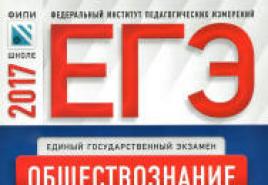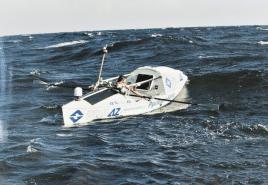The astronaut died. Georgy Grechko: biography and obituary
Biography of Georgy Grechko, story and episodes of life , an obituary about death. When born and died Georgy Grechko, memorable places and dates of important events in his life. Astronaut quotes, Photo and video.
Years of life of Georgy Grechko:
born May 25, 1931, died April 8, 2017
Epitaph
“Takeoff after takeoff shook the air.
The man said: - Now - I myself!
And the stars became closer in a minute
to youthful joyful eyes.
And in a minute all the millennia
the isolation of life on Earth
ended with a rocket flight -
on our mighty ship. "
Semyon Kirsanov, from the poem "Back!"
Biography
Georgy Mikhailovich Grechko did not not the first, not even the second or third astronaut in history... However, in his native country his fame was only slightly inferior to the fame of G. Titov or A. Leonov. Probably, the whole thing was in the enormous charm of the one whom the journalists called the most sociable astronaut.
Georgy Grechko's path into space did not begin with aviation, as with the first Soviet cosmonauts, but from technology. After graduating from the institute, he was assigned to the First Design Bureau, later he was appointed head of one of the working groups. Grechko took part in the work on the world's first artificial Earth satelliteas well as several spacecraft.
After being enrolled in the cosmonaut corps, Grechko began to prepare lunar program... When the race with the United States for the right to be the first to set foot on the moon was lost, the program was canceled. For several years Grechko remained in the backup crews of the Soviet Soyuz. But his time has come.

In Grechko's flights, about one and a half dozen world records were set. So the second space expedition with the participation of Georgy Grechko in 1977-1978. lasted a record 96 days at that time. On this expedition, Grechko made a spacewalk to inspect the station's docking station.
Later, Georgy Mikhailovich underwent training for international flights, and after completing his "space" career, he began working as an instructor and tester, and later - as a leading researcher at the Institute of Atmospheric Physics.
The astronaut admitted that in his youth he did not believe in aliens and aliens. However, at a more mature age, seriously studying the history of mankind, I came to the conclusion that other civilizations do exist. Georgy Mikhailovich said more than once that people should not stop developing, that a person should always strive for more. And then, perhaps, one day we will make sure that we are not alone in the universe.
Georgy Mikhailovich Grechko died at the age of 86 from heart failure.

Georgy Grechko aboard the Soyuz-26 space complex
Life line
May 25, 1931 Date of birth of Georgy Mikhailovich Grechko.
1955 g. Grechko graduated with honors from the Leningrad Mechanical Institute.
1966 g. Georgy Grechko enters the First Cosmonaut Corps of the USSR (now the Yuri Gagarin Cosmonaut Training Center).
1967 year Obtaining a PhD in Engineering Science.
1968 year Grechko is a member of the group for training Soviet cosmonauts to fly around the moon and land on it ("Probe").
1975 year Grechko's first flight into space (together with A. Gubarev) on the Soyuz-17 spacecraft as a flight engineer. Receiving the first Gold Star medal of the Hero of the Soviet Union.
1977 year Grechko's second flight into space (together with Yu. Romanenko) aboard the Soyuz-26 spacecraft and the Salyut-6 orbital station.
1978 year Rewarding the second Gold Star medal of the Hero of the Soviet Union.
1984 year G. Grechko received his doctorate in physics and mathematics.
1985 year Grechko's third flight into space (together with V. Vasyutin and A. Volkov) aboard the Soyuz T-14 spacecraft and the Salyut-7 orbital station.
1989 year Grechko is running for the people's deputies, but withdraws his candidacy in favor of B. Yeltsin.
April 1, 2017 Date of death of Georgy Grechko.
Memorable places
1. BSTU "Voenmekh" them. Ustinov (formerly the Leningrad Mechanical Institute), graduated from G. Grechko.
2. Rocket and space corporation "Energia" named after SP Korolev (OKB-1), where Grechko worked.
3. Star City, base of the Cosmonaut Training Center, where Grechko was preparing for flights.
4. Institute of Atmospheric Physics. A.M. Obukhov RAS, where Georgy Grechko worked as head. laboratory in the 1980s.
5. 81st hospital named after Veresaev in Moscow, where G. Grechko died.

Georgy Grechko at the presentation of his book "Cosmonaut No. 34" in 2013
Episodes of life
For 13 years, G. Grechko remained the oldest cosmonaut in the country to have been in orbit: he made his third flight at the age of 54.
In general, Georgy Grechko spent almost 135 days in space.
Grechko was involved in various sports: he had the title of Candidate Master of Sports in motorsport, the first category in parachuting, the second categories in gliding and shooting, and the third category in airplane sports.
The documentary of the First Channel “Georgy Grechko. I was in space, I believe in God "
Covenants
“A person always overcomes difficulties, goes beyond the horizon. Came out of the cave - little, swam across the river - little, crossed the Bering Strait from continent to continent, swam across the ocean - again a little, flew over the Atlantic Ocean on a single-engine plane - again little. A man is a man because he is constantly drawn to the horizon. "
“For science to work for a person, and not against him, morality is necessary ... Science must strive for achievements, but there must necessarily be a religion that cares about morality ... I do not agree with those who oppose these two areas. Religion deals with the human soul, and science - with the mind, bodies. Everyone has their own tasks. "
"... there is no better job than in space, but there is no better life than on Earth!"
Condolences
“The man was very interesting and cheerful. It was the sun that shone in our sky. "
Oleg Mukhin, First Vice-President of the Russian Cosmonautics Federation
“When the image of Georgy Mikhailovich appears, a smile always appears on the face. Not with him, with me. He was an amazing person in terms of charm. "
Alexander Lazutkin, cosmonaut
"We love him very much and remember him, he was a very bright person."
Olga, daughter of G. Grechko
The death of the astronaut Grechko came at 6:40 am. Twice Hero of the Soviet Union died in Moscow's 81st Veresaev City Clinical Hospital.
ON THIS TOPIC
Georgy Grechko's daughter Olga said that the astronaut died due to chronic diseases. According to her, the pilot smiled in the last minutes of his life. "He was strong. And so my mother was with him and he kissed her hand and smiled. He loves us all," the REN TV channel quotes Olga.
The circumstances of the death became known to the first vice-president of the Russian Federation of Cosmonautics, Oleg Mukhin. According to him, the cosmonaut kept his sanity before dying. “Two weeks ago we talked to him, but said that his health was poor,” Life.ru quotes him.
Recall that Georgy Grechko died on the morning of April 8. The official cause of death was acute heart failure.
On the eve of April 7, there were messages on the Internet about the hospitalization of the astronaut. As reported, later his daughter denied this information.
Georgy Grechko - Soviet cosmonaut, twice Hero of the Soviet Union. He flew into space three times - in 1975, 1978 and 1985. Interestingly, Grechko made his last flight at an advanced age: he was 54 years old. The astronaut was fond of racing, skydiving, as well as shooting and collecting stamps.
Cosmonaut Georgy Mikhailovich Grechko died of heart failure at the age of 85 on April 8, 2017. He was buried at the Troekurovsky cemetery in Moscow. He flew into space three times, studied science, conducted social activities, wrote books, and was married three times.
Date of death of Georgy Mikhailovich
The night of April 8, 2017 was the last in the life of the famous pilot-cosmonaut Georgy Grechko. Gone is the symbol of the era, a worthy man of his time, an example of decency and patriotism. The state appreciated his contribution to its history with two awards of the Hero of the USSR, the people - with love and respect.
Where and from what he died
The cosmonaut's life was cut short in the 81st hospital in Moscow at 6:40 am in the morning. On the previous day, a TASS message appeared about his hospitalization.
But this information was not confirmed by the daughter. According to her, Georgy Mikhailovich visited the hospital for the purpose of consultation: recently, his health has deteriorated significantly.
The cause of death of Georgy Grechko was heart failure, which developed against the background of age-related changes and existing chronic diseases.
The body was so weak that the resuscitation measures carried out in the hospital in the early morning of April 8 did not help. With the last heartbeats, life stopped.
The funeral of an astronaut
They buried Georgy Mikhailovich at the Troekurovsky cemetery, on the fourth day after he died - on April 11. The Alley of Cosmonauts became the last resting place.

The famous man died in the 86th year of his fruitful life. His entire biography is evidence of his service to the cause of space exploration and the development of society as a whole.
Brief biography of Grechko
Georgy was born on May 25, 1931 in Leningrad. Mother, a native of Belarus, worked as a chief engineer at a plant. Father is a junior researcher, originally from the Chernihiv region of Ukraine. In his son, he saw the continuation of his profession, dreamed that Georgy would also be engaged in science. However, the character of his son testified that he would achieve more.
Childhood and youth
There was no carefree childhood, because when he was 10 years old, the war began. For two years, the boy was sent to Ukraine to his grandmother, where he experienced all the hardships of life in the occupied territory. Returning, he continued to study and in 1949 he graduated from school.
Somehow as a gift he was presented with an album with stamps. This was the beginning of life's hobby - philately. The entire collection of collected stamps was dedicated to astronautics.
Georgy set off on his first exploration expedition at the age of 16. This was the Arctic. However, most of all, he was attracted by interplanetary travel. Reading many books on this topic, he believed that his dreams were destined to come true.
After leaving school, Georgy entered the Leningrad Mechanical Institute, which he successfully graduated in 1955. He was assigned to the design bureau. S. Korolev, where he defended his diploma.
Milestones at a glance - video:

With the choice of such a labor path, life has forever become associated with flying vehicles: rockets, spaceships for launching into orbit.
Enrollment in the cosmonaut corps
The acquired technical knowledge and the available enthusiasm allowed George to participate in the development of missile and other aircraft projects.
Later he was put in charge of a group of future test cosmonauts. April 1968 brings the status of a tester, and May - enrollment in the cosmonaut corps.
Interesting: the first cosmonauts were recruited from among persons - military pilots. However, according to S.P.Korolev, it was necessary to partially involve civilians. Often the choice fell on the employees of OKB-1, as happened with Grechko.
For some time, the young man was in reserve - he broke his leg in an accident. After that, long exhausting training began, improving existing knowledge and acquiring precious experience.

According to the program existing at that time, the cosmonaut was preparing for a flight to the moon. However, this program was soon closed, and they began to prepare him for piloting Soyuz-class ships. This also included theoretical and practical issues of work on orbital stations of the Salyut type.
The result of this training was the inclusion of Georgy Mikhailovich in the reserve composition of Soyuz-9 in June 1970 and Soyuz-12 in 1973.
As time went. The moment has come for real work, towards which Grechko has been going all the previous years. April 10, 1975 was the day he made his first space flight on the Soyuz-17 spacecraft with flight engineer Alexei Gubarev. In orbit for 29 days, their ship landed on February 9.
Space flights

During his working life, he made 3 space flights. Their total duration was 134 days and 20 hours. There was an open spacewalk lasting an hour and 28 minutes. A brief description of flights is presented in the table:
The first flight involved astrophysical research to study the Sun and planets, taking into account the wide range of electromagnetic radiation options.
During the flight, Grechko received an official reprimand for unauthorized elimination of the telescope malfunction (as an unplanned action). This flight ended difficult, as a squally wind rose during the landing. As a result, Gubarev was left with a spinal injury, and Grechko received a fracture of his lower limb.
A feature of the second flight was spacewalk. It happened on December 20. The goal was to determine the quality of the docking station. They spent 1 hour and 28 minutes in open space. At the same time, the goal was to test a new type of spacesuits with an oxygen supply designed for six hours.
It was during the first two flights that Georgy Grechko was twice awarded the title of Hero of the USSR.
The third flight was also special: the pilot-cosmonaut made it at the age of 54, which was a personal achievement.
Later, the cosmonaut was included in the preparation for international flights. 1984 - he is an understudy of the Soviet-Indian crew of the Soyuz T-11.
In 1988, Grechko was asked to prepare for the next flight. However, he did not dare to continue such a career. After leaving the cosmonaut corps, he began to work at the Institute of Atmosphere of the Russian Academy of Sciences. The existing baggage of theoretical and practical knowledge made it possible to quickly defend a doctoral dissertation.
Other work
GM Grechko was a man of broad outlook and active energy. After the end of his space career, he could not rest on his laurels. His subsequent work biography was of a creative nature.
He is an active consultant to the creators of space films:
- "Purple ball";
- "Under the constellation Gemini";
- "Shouldn't we send ... a messenger";
- autobiographical documentary subjects “Georgy Grechko. The trajectory of fate ”and“ Georgy Grechko. I was in space, I believe in God. "
As a result of cooperation with the Kultura TV channel, a series of films about the Moon and other planets was released.
In 1977-1990 he acted as the host of the program "This Fantastic World", the heroes of which are science fiction writers.
Life for such an active person could not consist only in passive observation of events. In 2006 he was offered to go on an expedition to the Sinai in Egypt. The goal is to search for the "cave of Moses" and the "white disc-shaped object". Georgy Grechko takes part in it with pleasure.
Four years later, a visit to the Chapel village, which has the status of an anomalous zone.
He was also engaged in ufological research. And in the last few years he was vice president of OTP Bank.
Collaboration with Alexei Gubarev later was the start for the filming of the popular science film "Mission to Orbit".
1986-1992 - Grechko headed the laboratory of the Institute of Atmosphere of the USSR Academy of Sciences, after that he worked here as a leading researcher.
The question of religion was not for Grechko unambiguous, as the psychology of that era demanded. In his memoirs, to the writing of which he approached very seriously, he reflected on the existence of the relationship between science and religion.
Interestingly, despite the atheistic views of her parents, one of the grandmothers dared to baptize her grandson in childhood. Later, the second grandmother repeated this action, not knowing about the previous one. That is why George Mikhailovich jokingly said that he had two guardian angels in heaven.

By the way, the second half of the life of this great man became close to God, as evidenced by numerous meetings with priests and discussion of views on the Universe with them.
Family life
The personal life of the cosmonaut was not insipid. There are three marriages in his biography:
- with Nina Tutynina, engineer of GKB NPO Energia;
- foreign language teacher Maya Kazekina;
- and the chief physician of the Cosmonautics Federation, Lyudmila Ovchinnikova.
Grechko had two sons from his second marriage - Alexei and Mikhail. In the third marriage, a daughter, Olga, was born.

A good attitude and love was enough for the whole family: three children and seven grandchildren, with whom Georgy Mikhailovich was always friendly.
He was not a boring, edifying father and grandfather. He loved downhill skiing and scuba diving, shooting and motorsport.
Lieutenant Colonel-Engineer Georgy Grechko had the degree of candidate master of sports in motor sports, the second category in gliding, the third in airplane sports, the second in rifle and pistol shooting.
As a person who was on the verge of the knowable, he loved science fiction and wrote several books himself. The plots were mostly about space. The book "Cosmonaut No. 34. From a Torch to Aliens" became especially popular.
The Soviet state spared no awards for its hero. For his work, as well as his contribution to the exploration of space and virgin lands, he received three Orders of Lenin, gold medals to them. Tsiolkovsky and them. Gagarin, several other medals.

On December 27, 2018, in Moscow, at 3 Khovanskaya Street, a memorial plaque was erected to the hero of the Soviet era, twice Hero of the USSR Georgy Grechko. The opening ceremony was attended by the city authorities, famous colleagues of the pilot-cosmonaut, veterans, relatives and friends.
The Soviet pilot-cosmonaut, twice Hero of the Soviet Union, Grechko Georgy Mikhailovich knew all of Russia and the post-Soviet space. The biography of a brave explorer, loyal and reliable comrade is full of interesting and sometimes fantastic events.
Childhood and youth
The childhood and adolescence of the future explorer and cosmonaut was spent in Leningrad. Here he was born. A happy event in the family of the father of the cosmonaut Mikhail Fedorovich and the mother of Alexandra Yakovlevna happened on May 25, 1931. Georgy's mother came to Leningrad from Belarus, his father came from Ukraine, so by nationality Georgy turned out to be half Ukrainian, half Belarusian.
A week before the attack of the Nazi invaders, a ten-year-old boy was taken to stay with his grandmother in Ukraine. For two years he lived in the occupied territory, in 1943 he returned home. In 1947, schoolboy Georgy Grechko went to the Kola Peninsula and took part in geological exploration.
He graduated from secondary school in 1949, entered the Leningrad "Voenmekh" and in 1955 finished it with excellent marks. After graduating from the institute, he was assigned to the S. Korolev design bureau; earlier, the diploma was defended here.

A young engineer with unique technical knowledge, together with other specialists, is developing a new rocket to launch the first artificial Earth satellite into orbit. Subsequently, he participates in preparations for the launch of other aircraft.
Cosmonautics
The era of cosmonautics was approaching, its finest hour. Work under the direction of Georgy Mikhailovich was the main thing. Engineers and scientists began to be accepted into the cosmonaut corps. Georgy passed a medical examination, his physical form, height and weight turned out to be suitable, and Grechko was among the lucky ones. So, at the age of 35 (in May 1966) he was enrolled in the cosmonaut.
First, Georgy Mikhailovich leads a group of future test cosmonauts, then in April 1968 he was appointed a test person, and in May he was enrolled in the cosmonaut corps of TsKBEM. The first flight is still far away, he gets into an accident, breaks his leg and is in reserve for a long time. In the meantime, the astronaut does not stop training and improves his skills.

As part of the group, Georgy undergoes general space training, preparing for flights to the moon under the Soviet program. After its closure, the cosmonaut is transferred to training for piloting Soyuz-type spacecraft and work at the Salyut orbital stations. At the launch of Soyuz-9 in June 1970 and Soyuz-12 in 1973, Grechko was part of the reserve crew.
Soon he leaves the "bench" and makes three flights into space. On January 10, 1975, on board the Soyuz-17 spacecraft, he embarks on the first space flight together with flight engineer Alexei Gubarev. The flight lasted 29 days, the cosmonauts returned to Earth on February 9.

On December 10, 1977, Soyuz-26 and the Salyut-6 - Soyuz-26 orbital complex are launched. Onboard engineer - Yuri Romanenko. The flight lasted 96 days (until March 16). On December 20, during the flight, the cosmonaut goes into open space to check and evaluate the station's docking station. Time spent in open space - 1 hour 28 minutes. During the first two flights, Grechko was twice awarded the title of Hero of the Soviet Union.
On September 17, 1985 Grechko's third flight took place on the Soyuz T-14 spacecraft as a flight engineer. The flight program was short-term during the shift to Salyut-7. The cosmonaut returned to earth on September 26 on the Soyuz T-13 spacecraft. This flight was made by him at the age of 54, which was another achievement of the cosmonaut.
 Cosmonaut Georgy Grechko (left) as a member of the Soyuz-17 team
Cosmonaut Georgy Grechko (left) as a member of the Soyuz-17 team Between the second and third flights, Grechko was trained in international programs. In April 1984, he was included in the backup Soviet-Indian crew of the Soyuz T-11. For three flights, the time spent in space was 134 days 21 hours 32 minutes 52 seconds.
In 1989, the cosmonaut was nominated for people's deputies, but he casts his votes.

In 1977-1990 he conducts the program "This Fantastic World". The heroes of the program were popular science fiction writers. For decades, Grechko collaborated with filmmakers to help create films about space. He became the main consultant for the films Purple Ball (1987) and Under the Constellation Gemini by Boris Ivchenko (1979). Grechko played himself in "Shouldn't we send ... a messenger?" (1998).
The cosmonaut's filmography also includes two documentaries of 2011 “Georgy Grechko. The trajectory of fate ”and“ Georgy Grechko. I was in space, I believe in God. " In the same year, the cosmonaut collaborated with the Kultura TV channel. Grechko became an expert for the popular science film "Living Universe". The cycle consisted of four pictures about the Moon, Venus, Mars and the Sun.

In the second half of his life, Georgy Grechko consciously came to faith. Initially, Grechko was looking for signs of the life of aliens, and in the 60s he even went with the expedition of Sergei Pavlovich Korolev, created on the occasion of the study of the alleged alien spacecraft, which, in their opinion, was actually the Tunguska meteorite. Later Grechko was engaged in ufological research together with Vadim Chernobrov.

In 2006, they set out on an expedition to find a "cave" and a "white disc-shaped object" in Sinai in Egypt. Four years later, colleagues organized a trip to the village of Chapel in the Pavlovo-Posad region, which is considered an anomalous zone.
In his memoirs, the cosmonaut reflected on the role of science and religion in the fate of mankind and came to the conclusion that science is neutral in relation to good and evil. Since the parents were atheists, one of the boy's grandmother in childhood secretly baptized her grandson. But the second did not know about this, so she again turned to the clergy for the sacrament. Later, Georgy Grechko jokingly said that he had two guardian angels.

After the flights, Georgy Grechko had to answer the reporters' favorite questions: about aliens and about God. The astronaut used jokes for his answers. Initially, George claimed to have seen a UFO through the porthole. Then the astronaut corrected himself that it was a joke.
In an interview, Grechko also told an anecdote about God, whose existence was asked after the flight by the Pope. The meaning of the story, according to the astronaut, boiled down to the fact that God should be sought not in space, but in the soul. Many phrases of the astronaut were perceived as aphorisms and were used as quotations.
Personal life
Georgy's personal life was also eventful, as evidenced by three marriages, the presence of children and grandchildren. The first wife of the pilot-cosmonaut was his contemporary Tutynina Nina Viktorovna, an engineer at the State Design Bureau of NPO Energia. In the second marriage with a foreign language teacher Kazekina Maya Grigorievna (born in 1938), two children were born - sons Alexei (1958) and Mikhail (1962).
The third wife was Lyudmila Kirillovna, born in 1953, who worked as the chief physician in the Federation of Cosmonautics. In 1979, a daughter, Olga, was born in the family.

Georgy Mikhailovich had many different hobbies: he went downhill skiing, dived, was engaged in shooting and loved motorsport. Since childhood, after he was presented with an album with stamps, he became interested in philately. The collection of his stamps is dedicated to astronautics.
Grechko was a passionate admirer of science fiction and works of the classics of world literature:, and others. He himself also wrote and became the author of several books. One of them - "Cosmonaut No. 34. From a torch to aliens" - contains memories of people, space flights, funny and a little sad stories from life. The book contains many unique photos and drawings.

For many years Grechko did not care about the health of the space veteran, and he remained the oldest of all astronauts living in the new century.
Death
Pilot-cosmonaut Georgy Grechko early in the morning on April 8, 2017 at the age of 85. Information about preliminary hospitalization was not confirmed. According to his daughter, he came to the hospital to consult a doctor. Before his death, Georgy Grechko experienced a sharp drop in pressure, which even resuscitation means did not help to restore.

In the last minutes, his wife Lyudmila was next to her husband. The cause of death is heart failure. The funeral of Georgy Mikhailovich Grechko took place on April 11 in Moscow at the Troekurovsky cemetery. The grave of the hero of the USSR is located on the Cosmonauts Alley.
Awards
- 1961 - Medal "For Labor Distinction"
- 1070 - Medal “For Valiant Labor. In commemoration of the 100th anniversary of the birth of V. I. Lenin "
- 1970 - Medal "For the development of virgin lands"
- 1975, 1978 - Two medals "Gold Star" of the Hero of the Soviet Union
- 1975, 1978, 1985 - Three Orders of Lenin
- 2011 - Medal for Merit in Space Exploration






